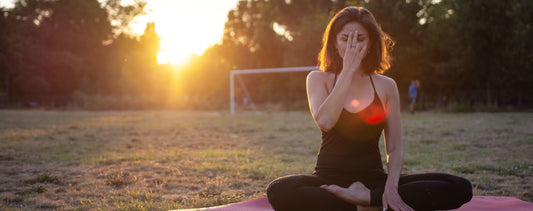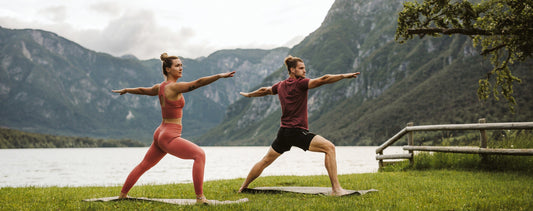From the ancient Yoga Sutras by Patañjali, the sutra sthira sukham asanam can be translated into English as “may the posture be steady and full of ease (or joy).” For anyone new to yoga, it might seem obvious to aim for steadiness and strength. Therefore, it is the prominence of sukham — signifying the eternal sense of joy, bliss, or ease within us — that may come as a surprise.
In many ways yoga appears to be serious and deep (because it is), and yet this sutra reminds us that an inner sense of playfulness is important, too. The goal of yoga is to observe and still the mind and thereby to connect to our natural state of ease, joy, and bliss. To that end, playfulness is as necessary as the discipline it takes to practice and study.
A few ways to cultivate playfulness in yoga postures are by practicing with children, slowing the practice down, and cultivating a “beginner’s mind.”
I have been teaching yoga and meditation since 2008, and since then several of my friends have told me how their toddlers naturally practice yoga postures. Young children will press up into downward dog, or while on their back they will grab their feet in happy baby pose. Watching young children explore with wonder and awe how their body moves is a perfect example of how we can prioritize playful exploration in our practice.
Yoga is not about forcing or pushing the body into an idealized form. Every body is different. The physical postures of yoga are meant to help us connect our mind, body, and spirit. To that end we gently move into one posture, then the next, not pushing past the edge where we feel that dynamic energy of strength and ease.
When I practice postures with my four-year-old niece she loves to start lying down. We extend one leg at a time into the air while the other leg is bent with the sole of the foot flat on the floor. We focus on the foot in the air and draw imaginary circles on the ceiling with our toes. Then, we start to draw bigger and bigger imaginary circles in the sky with the foot. After we do this with each leg, we practice a few more postures on the back before happy baby pose with both knees bent toward the shoulders, hands grasping the feet.
After we practice more postures tailored for her age and end with corpse pose (savasana), she says, “Again, again!”
We practice with lightness: no need to have a pose look “perfect,” to hold for a certain amount of time, or to judge the experience.
So much growth and learning happens with the combination of discipline, ease, and play. In tree pose, I tell her a trick for steady balance is to look at an object that is still. She tells me she sees a tree out of the window with a branch that is not moving. I encourage her to keep her gaze on that one point, and suddenly she holds a steady, focused tree pose as if by magic.
One of my favorite quotations is, “Nature does not hurry, yet everything is accomplished,” attributed to ancient Chinese philosopher Lao Tzu. Everything we do can be slowed down. We might digest better if we would eat slower, we might calm down if we would walk slower, and we might communicate better if we would speak slower.
Imagine how a yoga practice might look if everything was slow. Imagine slowing down even more than you just imagined. How slow could you move? Could you hold a pose longer to feel more benefit? Could you practice savasana for a longer amount of time than you usually do?
When I practice yoga slowly, I am more aware of each movement, of the way my mind and body are responding, and of how much calmer I become. After I enter that space of calm, steady movement, then joy bubbles up. Sometimes in the slowness, emotions arise and fall away as tears roll down my cheek. Through the process of slowing down and allowing whatever is to be as it is, tension melts and a quiet bliss — sukham — is the result.
Beginner’s mind allows us to come to each new moment with a fresh perspective. In yoga, it can be a way to release expectations for the practice to feel the same way today as it did yesterday. Beginner’s mind allows us to keep awareness on each breath and each movement with curiosity as if this is the first time we have experienced it.
With beginner’s mind, we can be curious, silently asking questions of the body and mind. How does it feel if I move this way? Can I go a little deeper in this pose? Do I need the extra support of a prop? How does the breath support me as I explore this posture?
Witnessing the physical movement, the breath, and the energy of the body as a beginner helps lighten the experience and bring a sense of playfulness to a practice you might have done thousands of times before.
These are a few ways to bring playfulness into the physical practice of yoga, and there are many additional ways for you to discover on your own.
*Editor’s Note: The information in this article is intended for your educational use only and is not a substitute for professional medical advice, diagnosis, or treatment. Always seek the advice of your physician or other qualified health providers with any questions you may have regarding a medical condition and before undertaking any diet, supplement, fitness, or other health programs.
Access your creative spirit and embrace your playful nature in Cultivate Creativity, a six-part collection with Devi Brown and Jasmine Hemsley, available now in the Chopra App.
In many ways yoga appears to be serious and deep (because it is), and yet this sutra reminds us that an inner sense of playfulness is important, too. The goal of yoga is to observe and still the mind and thereby to connect to our natural state of ease, joy, and bliss. To that end, playfulness is as necessary as the discipline it takes to practice and study.
A few ways to cultivate playfulness in yoga postures are by practicing with children, slowing the practice down, and cultivating a “beginner’s mind.”
Postures Through the Eyes of Children
I have been teaching yoga and meditation since 2008, and since then several of my friends have told me how their toddlers naturally practice yoga postures. Young children will press up into downward dog, or while on their back they will grab their feet in happy baby pose. Watching young children explore with wonder and awe how their body moves is a perfect example of how we can prioritize playful exploration in our practice.
Yoga is not about forcing or pushing the body into an idealized form. Every body is different. The physical postures of yoga are meant to help us connect our mind, body, and spirit. To that end we gently move into one posture, then the next, not pushing past the edge where we feel that dynamic energy of strength and ease.
When I practice postures with my four-year-old niece she loves to start lying down. We extend one leg at a time into the air while the other leg is bent with the sole of the foot flat on the floor. We focus on the foot in the air and draw imaginary circles on the ceiling with our toes. Then, we start to draw bigger and bigger imaginary circles in the sky with the foot. After we do this with each leg, we practice a few more postures on the back before happy baby pose with both knees bent toward the shoulders, hands grasping the feet.
After we practice more postures tailored for her age and end with corpse pose (savasana), she says, “Again, again!”
We practice with lightness: no need to have a pose look “perfect,” to hold for a certain amount of time, or to judge the experience.
So much growth and learning happens with the combination of discipline, ease, and play. In tree pose, I tell her a trick for steady balance is to look at an object that is still. She tells me she sees a tree out of the window with a branch that is not moving. I encourage her to keep her gaze on that one point, and suddenly she holds a steady, focused tree pose as if by magic.
Slow Down to the Pace of Nature
One of my favorite quotations is, “Nature does not hurry, yet everything is accomplished,” attributed to ancient Chinese philosopher Lao Tzu. Everything we do can be slowed down. We might digest better if we would eat slower, we might calm down if we would walk slower, and we might communicate better if we would speak slower.
Imagine how a yoga practice might look if everything was slow. Imagine slowing down even more than you just imagined. How slow could you move? Could you hold a pose longer to feel more benefit? Could you practice savasana for a longer amount of time than you usually do?
When I practice yoga slowly, I am more aware of each movement, of the way my mind and body are responding, and of how much calmer I become. After I enter that space of calm, steady movement, then joy bubbles up. Sometimes in the slowness, emotions arise and fall away as tears roll down my cheek. Through the process of slowing down and allowing whatever is to be as it is, tension melts and a quiet bliss — sukham — is the result.
Yoga with Beginner’s Mind
Beginner’s mind allows us to come to each new moment with a fresh perspective. In yoga, it can be a way to release expectations for the practice to feel the same way today as it did yesterday. Beginner’s mind allows us to keep awareness on each breath and each movement with curiosity as if this is the first time we have experienced it.
With beginner’s mind, we can be curious, silently asking questions of the body and mind. How does it feel if I move this way? Can I go a little deeper in this pose? Do I need the extra support of a prop? How does the breath support me as I explore this posture?
Witnessing the physical movement, the breath, and the energy of the body as a beginner helps lighten the experience and bring a sense of playfulness to a practice you might have done thousands of times before.
These are a few ways to bring playfulness into the physical practice of yoga, and there are many additional ways for you to discover on your own.
*Editor’s Note: The information in this article is intended for your educational use only and is not a substitute for professional medical advice, diagnosis, or treatment. Always seek the advice of your physician or other qualified health providers with any questions you may have regarding a medical condition and before undertaking any diet, supplement, fitness, or other health programs.
Access your creative spirit and embrace your playful nature in Cultivate Creativity, a six-part collection with Devi Brown and Jasmine Hemsley, available now in the Chopra App.






















